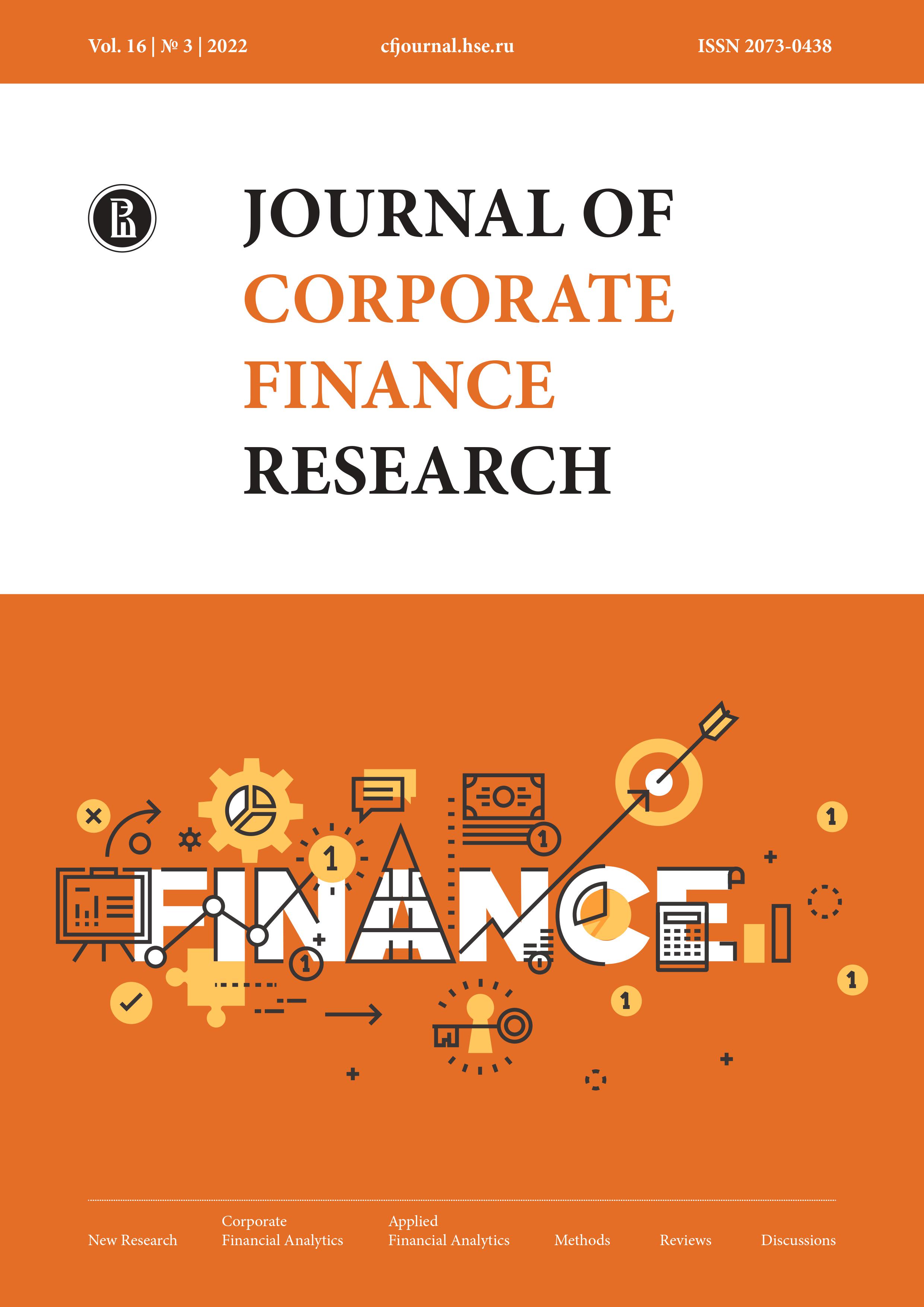The Efficiency of Environmental Project Financing with Green Bonds in the Energy Sector: Evidence from EU Countries
Abstract
This paper investigates whether the issue of green bonds by energy companies allows lowering the cost of funding for their environmental projects. We use empirical data on green bond placement in the energy sector and comparable conventional bond yield curves to prove the existence of the green bond yield discount. The sample includes 37 plain vanilla green bond issues and comparable yield curves of EU energy companies for 2017–2020 with total volume EUR 25 bn. We demonstrate that green bonds have a 4.7 bps lower average yield compared to conventional bonds. This green bond discount is statistically significant at a 5% level and does not depend on issue size or debut status of the issue. We draw three main conclusions: (1) energy companies may lower cost of funding by issuing green bonds, making environmental projects more economically attractive, (2) the green bond discount is present for both inaugural and subsequent green bond issues, which makes it reasonable to finance all environmental projects with green bonds, (3) the green bond discount does not depend on the issue size, which makes green bonds an appropriate choice for financing capital-intensive projects.
Downloads
References
Total energy consumption. Enerdata. URL: https://yearbook.enerdata.net/total-energy/world-consumption-statistics.html (accessed on 23.10.2022).
Pachauri R.K., Meyer L., eds. Climate change 2014: Synthesis report. Geneva: Intergovernmental Panel on Climate Change; 2015. 151 p. URL: https://www.ipcc.ch/site/assets/uploads/2018/05/SYR_AR5_FINAL_full_wcover.pdf (accessed on 23.10.2022).
Energy related greenhouse gas emissions, 2000-2021. IEA. 2022. URL: https://www.iea.org/data-and-statistics/charts/energy-related-greenhouse-gas-emissions-2000-2021 (accessed on 23.10.2022).
Karaeva A.P., Magaril E.R., Kiselev A.V., Cioca L.-I. Screening of factors for assessing the environmental and economic efficiency of investment projects in the energy sector. International Journal of Environmental Research and Public Health. 2022;19(18):11716. https://doi.org/10.3390/ijerph191811716 DOI: https://doi.org/10.3390/ijerph191811716
Preclaw R., Bakshi A. The cost of being green. Barclays. Sep. 18, 2015. URL: https://www.environmental-finance.com/assets/files/US_Credit_Focus_The_Cost_of_Being_Green.pdf (accessed on 09.08.2020).
Gianfrate G., Peri M. The green advantage: Exploring the convenience of issuing green bonds. Journal of Cleaner Production. 2019;219:127-135. https://doi.org/10.1016/j.jclepro.2019.02.022 DOI: https://doi.org/10.1016/j.jclepro.2019.02.022
Zerbib O.D. The effect of pro-environmental preferences on bond prices: Evidence from green bonds. Journal of Banking & Finance. 2019;98:39-60. https://doi.org/10.1016/j.jbankfin.2018.10.012 DOI: https://doi.org/10.1016/j.jbankfin.2018.10.012
Sheng Q., Zheng X., Zhong N. Financing for sustainability: Empirical analysis of green bond premium and issuer heterogeneity. Natural Hazards. 2021;107(3):2641-2651. https://doi.org/10.1007/s11069-021-04540-z DOI: https://doi.org/10.1007/s11069-021-04540-z
Green bond highlights 2017. London: Climate Bonds Initiative; 2018. 6 p. URL: https://www.climatebonds.net/files/reports/cbi-green-bonds-highlights-2017.pdf (accessed on 10.11.2019).
Karpf A., Mandel A. The changing value of the ‘green’ label on the US municipal bond market. Nature Climate Change. 2018;8(2):161-165. https://doi.org/10.1038/s41558-017-0062-0 DOI: https://doi.org/10.1038/s41558-017-0062-0
Emets M.I. Modeling the green bond yield on bond offering. Finansy i kredit = Finance and Credit. 2020;26(12):2858-2878. (In Russ.). https://doi.org/10.24891/fc.26.12.2858 DOI: https://doi.org/10.24891/fc.26.12.2858
Mikhaylova A., Ivashkovskaya I. Do investors pay yield premiums on green bonds? Journal of Corporate Finance Research. 2020;14(2):7-21. https://doi.org/10.17323/j.jcfr.2073-0438.14.2.2020.7-21 DOI: https://doi.org/10.17323/j.jcfr.2073-0438.14.2.2020.7-21
Statman M., Glushkov D. The wages of social responsibility. Financial Analysts Journal. 2009;65(4):33-46. https://doi.org/10.2469/faj.v65.n4.5 DOI: https://doi.org/10.2469/faj.v65.n4.5
Semenova N., Hassel L.G. Industry risk moderates the relation between environmental and financial performance. Sustainable Investment Research Platform Working Papers. 2008;(2). URL: http://web.abo.fi/fak/esf/fei/redovisa/kurser/Lasse/Mistra%20wp/sirp%20wp%2008-02%20Semenova%20and%20Hassel.pdf (accessed on 10.11.2019).
Heinkel R., Kraus A., Zechner J. The effect of green investment on corporate behavior. The Journal of Financial and Quantitative Analysis. 2001;36(4):431-449. https://doi.org/10.2307/2676219 DOI: https://doi.org/10.2307/2676219
Sharfman M.P., Fernando C.S. Environmental risk management and the cost of capital. Strategic Management Journal. 2008;29(6):569-592. https://doi.org/10.1002/smj.678 DOI: https://doi.org/10.1002/smj.678
Chava S. Environmental externalities and cost of capital. Management Science. 2014;60(9):2223-2247. https://doi.org/10.1287/mnsc.2013.1863 DOI: https://doi.org/10.1287/mnsc.2013.1863
Magnanelli B.S., Izzo M.F. Corporate social performance and cost of debt: The relationship. Social Responsibility Journal. 2017;13(2):250-265. https://doi.org/10.1108/SRJ-06-2016-0103 DOI: https://doi.org/10.1108/SRJ-06-2016-0103
Menz K.-M. Corporate social responsibility: Is it rewarded by the corporate bond market? A critical note. Journal of Business Ethics. 2010;96(1):117-134. https://doi.org/10.1007/s10551-010-0452-y DOI: https://doi.org/10.1007/s10551-010-0452-y
Stellner C., Klein C., Zwergel B. Corporate social responsibility and Eurozone corporate bonds: The moderating role of country sustainability. Journal of Banking & Finance. 2015;59:538-549. https://doi.org/10.1016/j.jbankfin.2015.04.032 DOI: https://doi.org/10.1016/j.jbankfin.2015.04.032
Oikonomou I., Brooks C., Pavelin S. The effects of corporate social performance on the cost of corporate debt and credit ratings. The Financial Review. 2014;49(1):49-75. https://doi.org/10.1111/fire.12025 DOI: https://doi.org/10.1111/fire.12025
Ghouma H., Ben-Nasr H., Yan R. Corporate governance and cost of debt financing: Empirical evidence from Canada. The Quarterly Review of Economics and Finance. 2018;67:138-148. https://doi.org/10.1016/j.qref.2017.06.004 DOI: https://doi.org/10.1016/j.qref.2017.06.004
Cai N., Helwege J., Warga A. Underpricing in the corporate bond market. The Review of Financial Studies. 2007;20(6):2021-2046. https://doi.org/10.1093/rfs/hhm048 DOI: https://doi.org/10.1093/rfs/hhm048
Hotchkiss E., Jostova G. Determinants of corporate bond trading: A comprehensive analysis. The Quarterly Journal of Finance. 2017;7(2):1750003. https://doi.org/10.1142/S2010139217500033 DOI: https://doi.org/10.1142/S2010139217500033
Richardson S., Palhares D. (Il)liquidity premium in credit markets: A myth? The Journal of Fixed Income. 2019;28(3):5-23. https://doi.org/10.3905/jfi.2018.1.065 DOI: https://doi.org/10.3905/jfi.2018.1.065
Nelson C.R., Siegel A.F. Parsimonious modeling of yield curves. The Journal of Business. 1987;60(4):473-489. https://doi.org/10.1086/296409 DOI: https://doi.org/10.1086/296409
Market data. Climate Bonds Initiative. URL: https://www.climatebonds.net/market/data (accessed on 23.10.2022).
Copyright (c) 2022 National Research University Higher School of Economics

This work is licensed under a Creative Commons Attribution-NonCommercial-NoDerivatives 4.0 International License.

